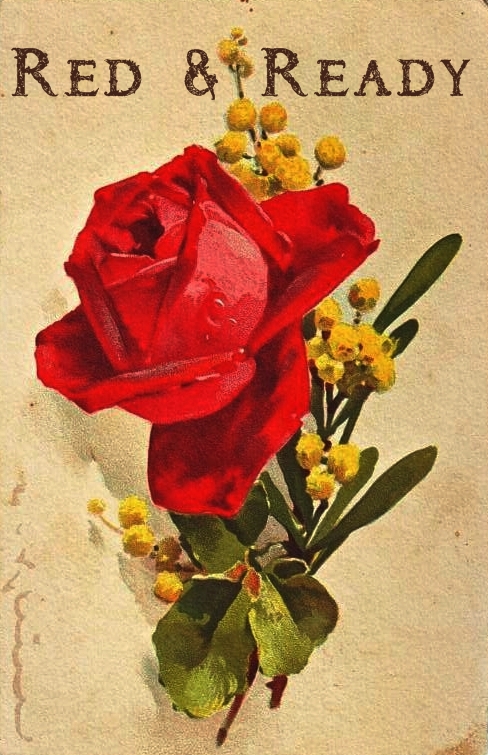
February was a trying month for me. But, trials & tribulation can’t keep a farmgirl down for long. We have our hearts set on brighter tomorrows and better things ahead. Speaking of ‘better’, RED is better! So, with that in mind, I’m puttin’ my RED on. I’m ready for a refreshing re-start.
.jpg)
Red is my favorite color. It is the hue of life & love. I took a look around yesterday and noticed, “Hey, there’s RED all around me.” I was encouraged, then reminded, “Get your RED on, girl !”
So, I did, literally. Can’Ya believe I found a pair of my favorite Keen shoes in RED?!
Then, one red thing led to another.
.jpg)
For a farmgirl, nothing warms and cheers the heart more than baby things … especially newborn poultry peepers. I’ve not incubated eggs for several years. Instead, I opted to purchase the breed I wanted. Admittedly, it is easier. However, the anticipation and joy involved in hatching out your own baby chicks is a springtime wonder of wonders. Hearing those first tiny peeps makes a farmgirl’s heart go pitter-patter. Right?
The ‘Keep Calm And Keep Chickens’ image above [spotted on Pinterest] caught my attention … and soon after, an inkling turned into a decision. Then, it was just a matter of picking a breed and ordering eggs. As for the image, it is a downloadable poster that you can purchase here: http://www.keepcalm-o-matic.co.uk/p/keep-calm-and-keep-chickens-3/
The thought process of revisiting hatching out my own eggs took me to my bucket of back issues of MaryJanesFarm magazines – the most recent edition, to be exact. MaryJane wrote the feature article, Choosing Your Backyard Chicken. She loves Buff Orpingtons. So do I, I have three right now. My farmgirl pal, Anita, has a flock of “Buffies”. I also have Wellsummers and Dominiques.
.jpg)
I admit, I love trying other breeds and having a colorful “bouquet” of poultry. Consequently, I’ve owned many breeds. I’m ready to try something new. So many breeds are more available now than ever before, and from so many sources. How does a farmgirl decide?!
For me, disposition is first and foremost. Character quality was also #1 when I was actively breeding Morgan Horses. Hmmm, come to think of it, the same was true when I chose my second (and FAVORITE) husband. :o) Shery, Shery, Shery … stay on topic!
ANYway, the first thing I wanted to know about breeds of chickens I’ve not yet owned is what kind of temperament the birds have – hen and rooster. I love a friendly sort, mild mannered in every way, the kind that makes a good pet … a “lap chicken”. Even if the hens are sweet, the male counterpart can be and often is, well, a JERK.
Secondly, appearance is important, I want pretty birds that decorate the barnyard :o). I’m not an egg “farmer”, so I don’t care so much about who wins the egg production contest. They ALL lay eggs and I don’t need hens that are heavy layers. After all, my husband and I can only eat so many eggs! On the other hand, as long as I’m feeding a flock, I do want the ladies to earn their keep.
While perusing internet info-sites dedicated to poultry, I learned more about the French Marans breed (pronounce Marans like Barons). They fit my criteria for temperament and appearance – even the roosters are mild mannered. The hens lay glossy dark brown eggs that are said to be “rich” – the french chef’s pick. Hmm. The strain of Marans I’ve had my heart set on is the Black Copper variety. A few other colors are available too. I tried to order BC Marans chicks a couple of years ago, but they were always sold out the closer you get to April. Sooo, I checked eBay last week. This time of year, many backyard poultry breeders sell their eggs on eBay. Vwa-Lah, there were several listings for BCs. Below are photos of a French Black Copper Marans rooster and hen. They have a little feathering down their legs.
As we speak, there are Black Copper Marans eggs in my incubator! I think these birds are just beautiful. Beetle-green black with brilliant coppery-bay accents. Their red combs look even more crimson set against black.
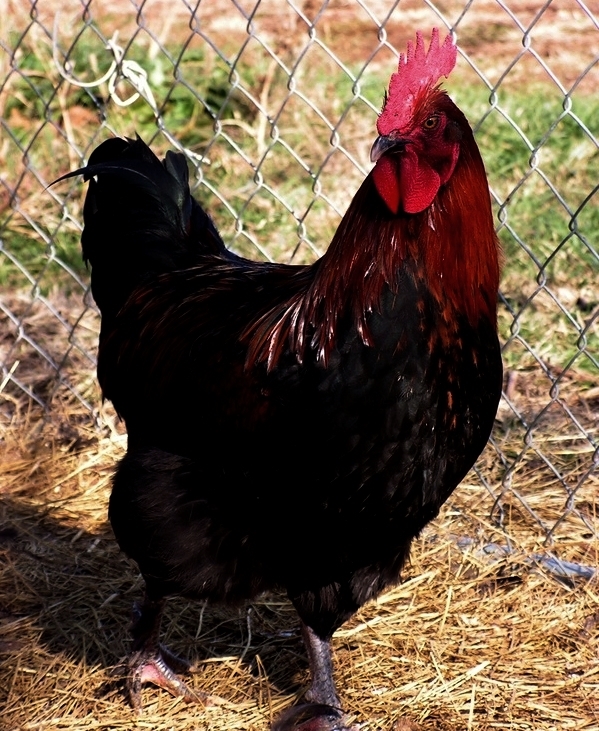
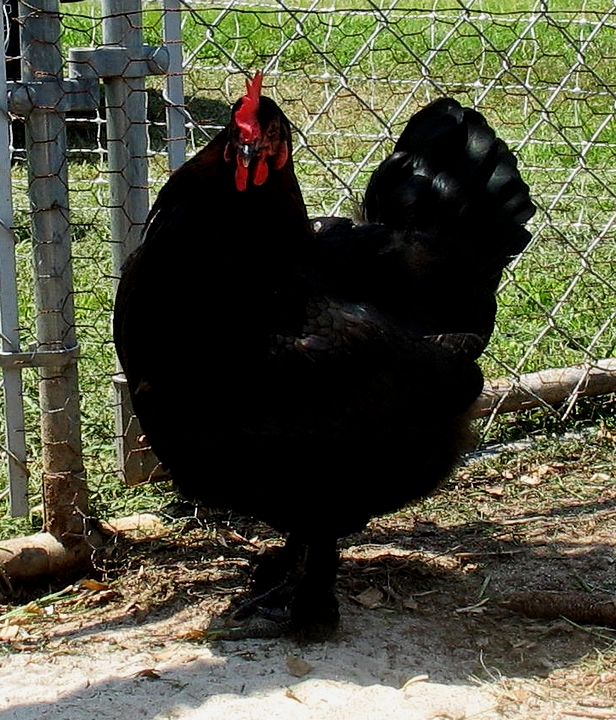
I bought an “old school” galvanized incubator at an auction years ago. It was clean and in great shape. I’ve hatched out hundreds of eggs in it – chickens, guineas, geese. You can incubate any kind of egg in it, but, it is specifically designed to accomodate goose eggs. The lid is taller and the thing measures 21″ around. It is roomy and tall enough for newly hatched goslings. They won’t burn their heads on the heating element. Here ‘tiz below. I marked the Marans eggs with Xs & Os with a pencil. Then, into the ‘oven’ they went. You mark them so you’ll know each one has been turned. Turning the eggs 2-3 times a day, early in the incubation period, is important.
I put two thermometers in the the incubator to give me the best read on temperature. Perfect temperature is 99.5. If it exceeds that a tiny bit, it is no big deal, but it shouldn’t be under that temp or exceed 102. Humidity is also important. I place a tea cup or two of water inside during the earlier time-frame of incubation. You don’t want the eggs to dry out too much. Incubation of chickens is right around 20 days. Sometimes you get “early birds” at 19 days and some at 21 days. Late hatchers usually don’t live and/or they need to be “delivered” from their egg prison. If you hear peeping inside and they are running late, they need help. I’ve performed that surgery many times – usually with success. You just have to go slow so that they don’t ‘bleed out’ of their tiny umbilical cord. It is a tweezers kind of surgery.
As for this batch of Marans eggs, I hope for the best! I’ve always had good luck with my own eggs in the past – usually around 80%. It has been about 7 years since I incubated eggs. The only total crop failure I experienced involved Call Duck eggs that I ordered. Call Ducks are bantam ducks and not one of those 24 eggs hatched. It was a very expensive disappointment too. The best hatches were Guineas – about 99%. I incubated lots of Guinea eggs for a friend, in exchange for garden goodies (back when I didn’t have a garden). She lost several guineas every summer to predation, so, every spring she’d collect a pile of eggs from her guinea hens and I’d ‘cook’ her up a fresh batch of bug hunters.
Sidenote: Guineas lay profusely, but they are absolutely thee worst mothers in the universe. Well, that is if they’re given the option of free-range. A guinea hen doesn’t look after her babies like a chicken does. No, she’ll lose most if not all of her 20 some babies the first day she takes them out & about. So, if you have a mind to raise guineas, raise them yourself in confinement. Or, better yet, assign a Silkie hen to the task of incubating and being their momma. Silkies are the diametric opposite of guineas as mothers. There is no better mother hen than a Silkie. Bar None. They’ll also mother their brood much longer than the usual 6 week limit of most hens. My Silkies even hatched out Canada Geese – one egg per hen — gospel truth. It was something to see those tiny bantam hens straddle a goose egg, but they were determined! I then gave the four goslings to one hen and put up a heat lamp to make sure the goslings were always warm since there was no way a Silkie hen could cover her BIG babies. That devoted little Silkie momma doted on her goslings long after they began flying! I’ll say it again: Silkie hens are the best mother hens in all of Chickendom.
Secondary use for an incubator: Cat warmer (below) :o) I’ll keep you posted on my Chick hatching project. My babies are due to hatch on or around Palm Sunday. So, after Easter, I hope to share baby pics with you when I post next time around.
While on the subject of chickens, I thought I’d share an opinion or seven in regards to breeds. I enjoy just about any kind of chicken, but I do have preferences and dislikes too. I dislike flighty birds – the kind you hand raise and they still act like nervous nitwitted ninkumpoops. When you walk in the coop, that kind of bird squawks and panics even though you do it every dang day. Chicken breed information webs sites are usually good about describing the temperament of birds. Generally, the “heirloom” breeds are more laid-back. Generally. But, among that genre, there are some that score reliably high when it comes to being user-friendly. Case in point, the lovely French Faverolle (below).
The French Faverolle is exceedingly sweet and mild. They are a good sized bird and are moderate layers of tinted ‘off white’ eggs. The rooster is the stately and unflappable Hereford bull of chickens – large and Oh So Gentle. Faverolles are sooo tame and mild-mannered that they’ll be at the very bottom of the pecking order in a mixed flock. For that reason, if and when I start from scratch again, choosing one breed to have around, I will go with a flock of Faverolles. That way, you have a peaceable kingdom, nobody gets bullied. The color you see here is called ‘Salmon’. I imagine because of the ruddy salmon shaded back feathers and mantle. Faverolles have a muffed face and lightly feathered shanks. They are a hefty bird and quite *fluffy* which makes them very cold hardy. The hens will sometimes go broody.
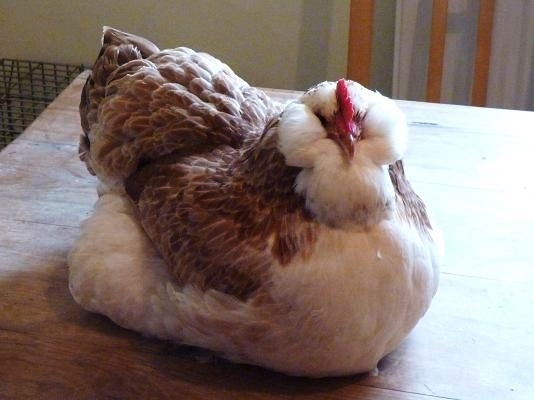
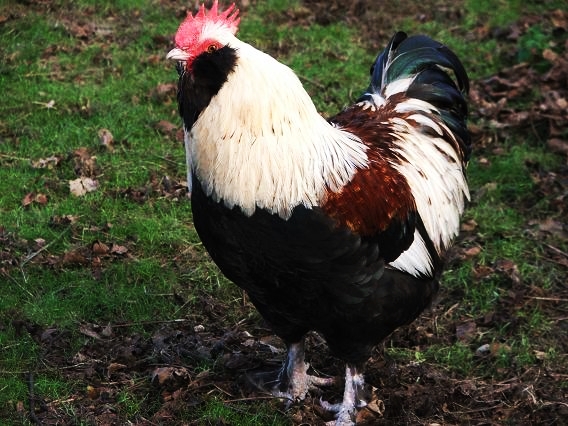
The Light Sussex is a breed I’ve not yet owned. They, too, are a very gentle, mild-mannered variety. They’re good layers and ‘meat’ birds since they’re heavier bodied. I love their coloring of snow white with crisp black accents. They look so clean and bright.
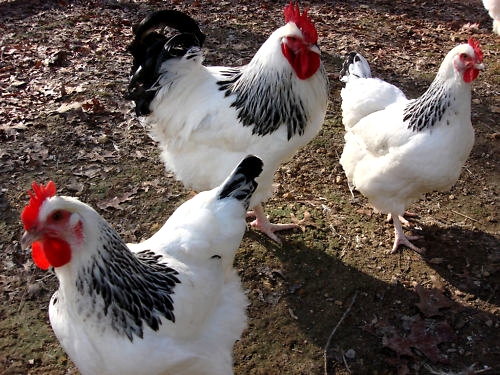
I also adore Dominques! Their barred feather pattern is much more intricate and fine than the much beloved Barred Rock. The Dominique hen is chatty and she becomes a pet very willingly. The other difference between a Dominique and a Barred Rock is that the Dominique has a pea comb instead of a straight comb. The Dominique nearly went extinct and I believe the breed is still on the endangered livestock list. The hens lay well and their eggs are a light pinky-brown.
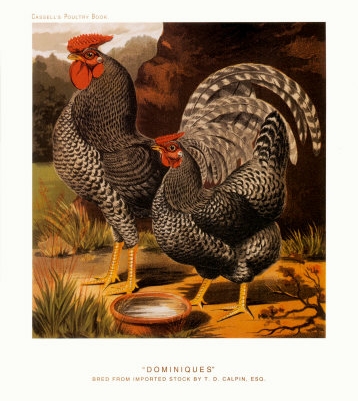
A word about Bantams. LOVE THEM. All I had was Bantam breeds for quite a spell. Favorites: #1 – Bantam Cochins (aka Pekins), Silkies, Belgian Antwerp, Rhode Island Red. I had many other varieties, but the afore mentioned are my faves. Pekin hens are adorable little creatures. Also, they have cuter facial features than their full sized kin.
A word about Polish chickens (the kind with opulent fluffy poodle-like top knots). If you want free-range birds, do not go Polish. They’re the very first to be picked off by predators because they cannot see. For a chicken (favored food of any and all predators), keen eyesight is a MUST-HAVE.
A word about “poultry guardians”: This area, for several years, was over populated with fox, to the point that a plague ensued as a cure for the problem. When man fails, Nature takes care of the problem. Anyhow, the primary reason I got to try sooooo many breeds of chickens was due to my flock getting all but wiped out at some point every year. Oh yes, town dogs did their part also. Then skunks, then hawks. Everyone likes to eat chicken. The true cure for all of my poultry woes was not a pen. It was Rat Terriers!!! They saved my poultry project. Many other breeds of terriers will do the same job for you. Terriers are ON PATROL and they take guarding the farmstead seriously. They’re fearless, die-hard varmint haters. I lost one, ONE chicken after my two Rat Terriers were mature. Nuff’ said. Below: Early litho print of a Rat Terrier and her puppies.
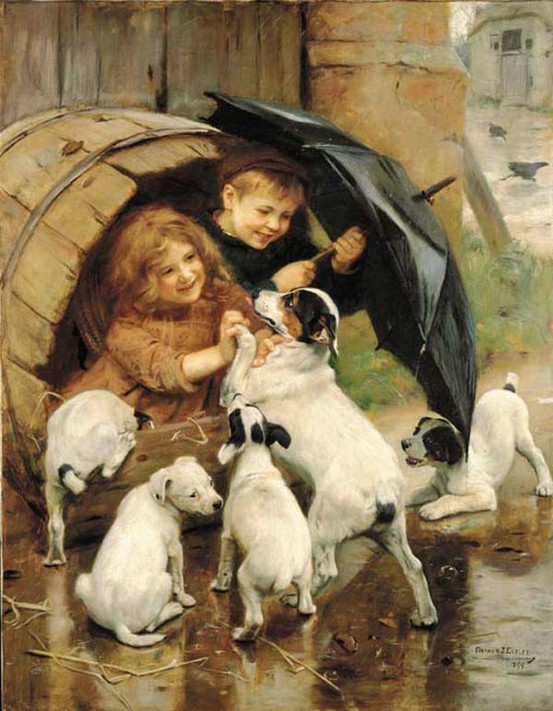
On the philosophical side, chickens aren’t just good in a pot with noodles, they’re good for the soul. There is nothing happier than a happy chicken and so many things make a chicken happy. Perhaps it has something to do with them knowing that every meat-eater in the world likes to eat chicken (including us). Maybe the reason that chickens are, by nature, happy creatures is that they’re just happy to be alive. They live in the moment, knowing it could be their last. :o)
A baby chick asleep in the palm of your hand is a picture of contentment. Likewise, an otherwise busy hen lays down on her side, spreads her wing out in a sunny spot on the south side of the barn, closes her eyes and enjoys an afternoon nap. Treats – a chickens favorite thing, whether it be table scraps or vegetable trimmings. Bath time. While we bathe in water, chickens favor soft dirt. And, they don’t just bathe, they love to bathe and linger in the experience.
We can take a lesson from the chicken: Be easier to please, easier to delight. When you’re busy in the fast lane of life, take time to park in the sun and soak up some of the light, not just the heat. Know what I mean, jellybean?? And, when you bathe … linger. Let the water beat down on your back. Slump over, soak up the hydro-therapy and breathe deeply the steamy humidity. The simple luxuries in life go a long way. Chicken wisdom :o)
Ok, back to RED and looking forward. Tulips. I planted some unusual red ones last fall that I hope survived. They’re similar to these two-toned beaties … dark red and bright red.

There are other red-heads around here too. I’ve mentioned here before that hanging birdfeeders or mounted varieties just don’t work here. Well, then, Collared Doves came and stayed. Now I have a new customer. Well, not new, but they discovered that there is a lot more to eat in a feeder than on the ground. American Tree Sparrows (Spizella arborea) frequent my feeders now. I know they aren’t showy, as birds go, but they give me something to delight in and they’re bold little birdies like Chickadees. They have rusty-red caps and a spot on their breasts.
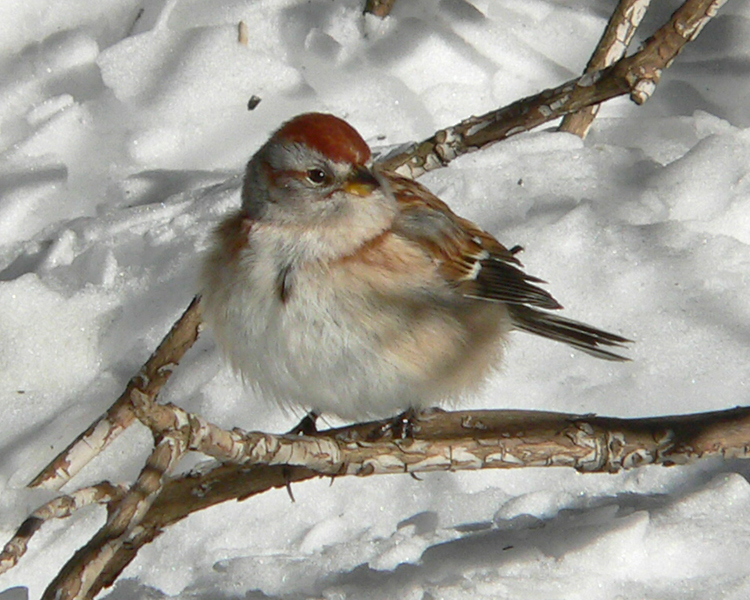
So, now that I have more than one kind of bird to feed, I opted to put more feeders out so that everyone gets something to eat. I made a covered feeder out of a ‘vintage’ enamelware pot and lid. If you’d like instructions about the How-To, you can get them by subscribing to the MaryJanesFarm sisterhood newsletter (The Cluck). The instructions are in the new newsletter issue that is sent out as a ‘virtual’ magazine via email.
.jpg)
Ok, here is another ‘red head’ — my 3 year old filly, “Apple”. She is offically ‘under saddle’ now. A few days ago, we had a 60 degree day! So, I piddled around with her – doing horsie kindergarten things. My husband trimmed her hooves. I walked her down the driveway all by herself which is a BIG thing for a youngster. She received a hair-cut too – a bridle path. After all, she’s soon going to graduate to saddlehorse-hood and is no longer a baby.
The first week of April, we’ll bring our first-calf heifers home for calving. We’ve got several red-heads this year, courtesy of a Hereford bull. The below photo also shows you how close we are to the Black Hills that leak into Wyoming from South Dakota. If you could scan to the left of this photo about 6 inches, you’d also see Devil’s Tower off in the distance.
The girls above just had their meal rolled out for them. We’ll feed hay full-time until the first of April or until it is too muddy to go out. The hay we bought last fall is wheat hay and it was put up just right – “in the dough”, as they say. Wheat hay needs to be cut when it is still quite green. There is still plenty of nutrition in the stem; the head/kernels are soft. Over dry wheat hay can cause a cow to develop horrible sores in their jaws. Anyway, this bunch of hay has been very good, the cows love it and they look “bloomy”.
.jpg)
While I was taking these photos, Canada Geese flew over. Love hearing goose music this time of year. Soon, the Meadowlarks will return … then the bluebirds … then all the other summer residents!
.jpg)
I suppose some of you living in more southerly climes already have spring blossoms? Don’t they smell divine. I mean that literally. I’ll betchya there is a country corner in Heaven that smells like a mix of our favorite farmgirl flowers. For now, springtime right here on Earth is a lil bit of Heaven. I’m ready!





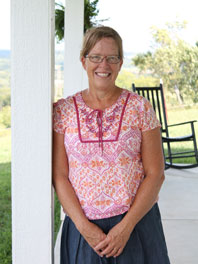
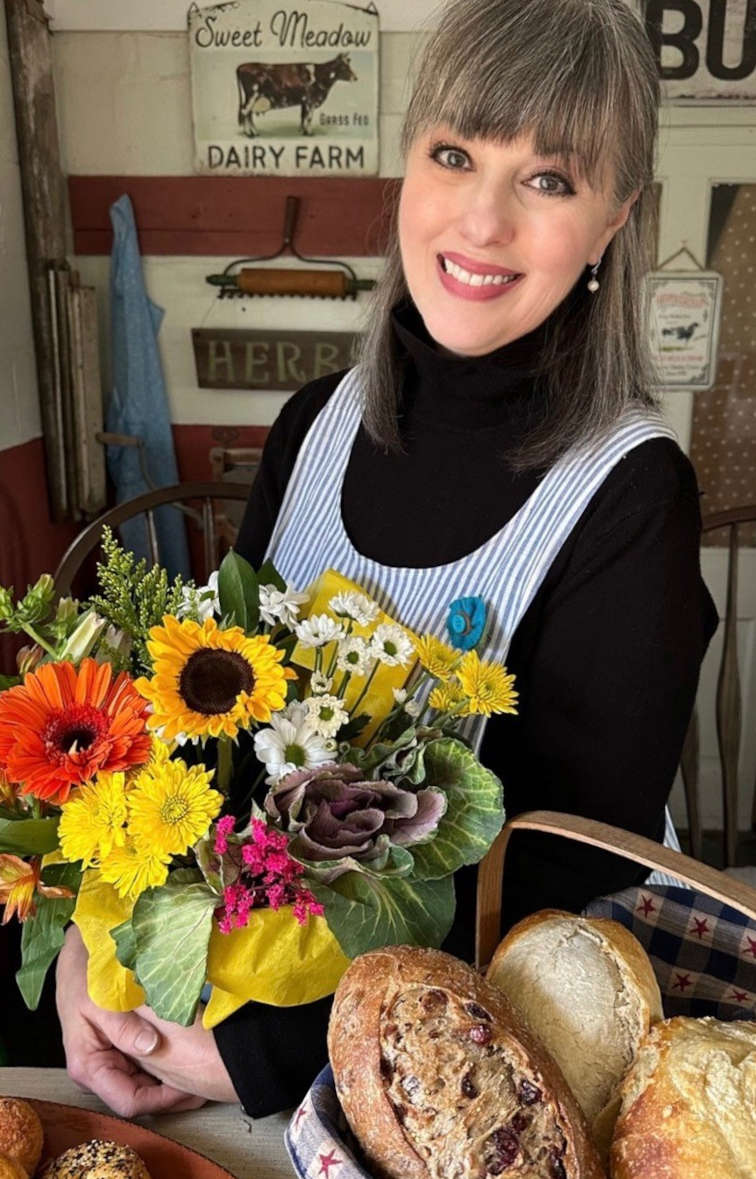




Red is good on ya Shery!!
Luv your speckle enamelware bird feeder…
We have been having Geese passing through, I love hearing them honk… no bluebirds or meadowlarks yet… but the magpies are busy grubbing. Yep, Spring is almost here!
Had a mama deer & her 2 toddlers feed on the apples/hay & corn we put out in the trough.. luv watching them as they cross between our home & barn… See, Spring is in the air! :>)
Another wonderful visit – thanks much Shery. Love hearing about the chicks – we got some a few weeks ago and they are doing very well – we are hand raising them. Thanks for all the great pictures. God Bless
I smiled all the way through your post. I don’t have any, but chickens have always looked like pure fun to me. Hearing your descriptions and seeing your pictures makes me feel like I get to be part of your lifestyle. Thank you! I have a new goal now. They always say try to be as good as your dog, but now I will add trying to be as happy as a chicken!
Just tickled to hear you have a Hereford bull amongst your ladies! We have a lovely set of black baldies by our Hereford bull that we are so happy with as they are turning one year old. Good luck with yours! And with your "Apple" girl too!